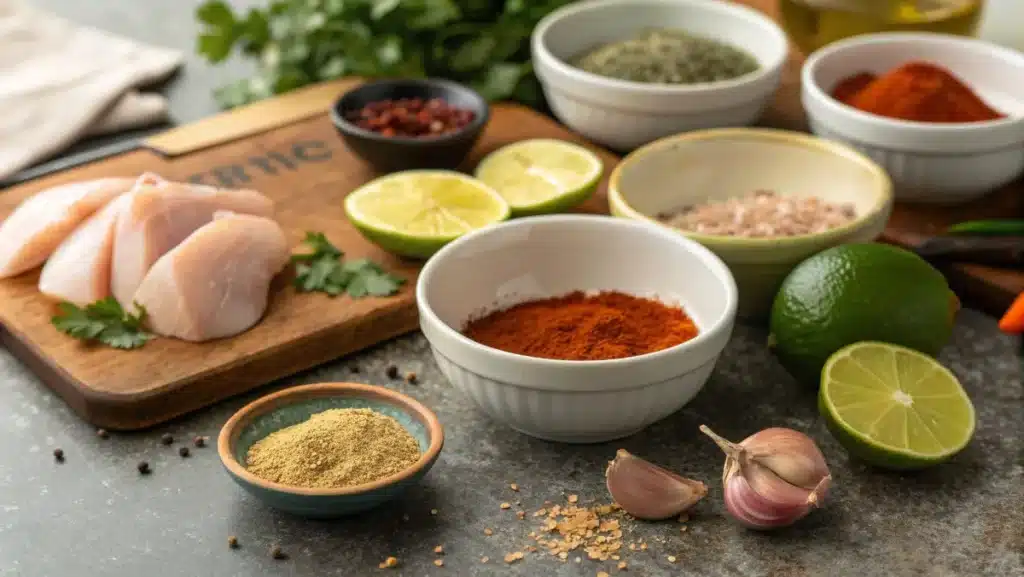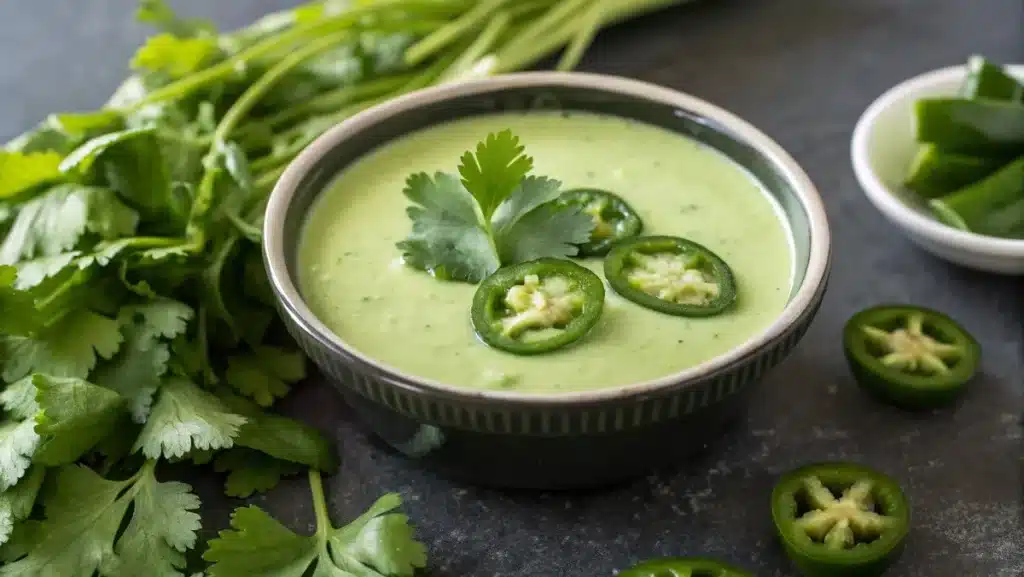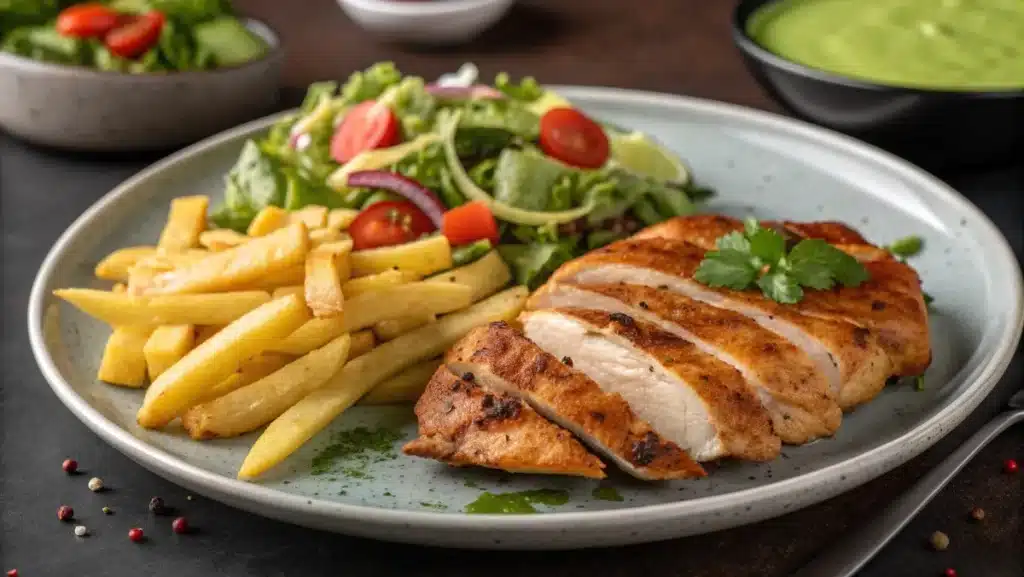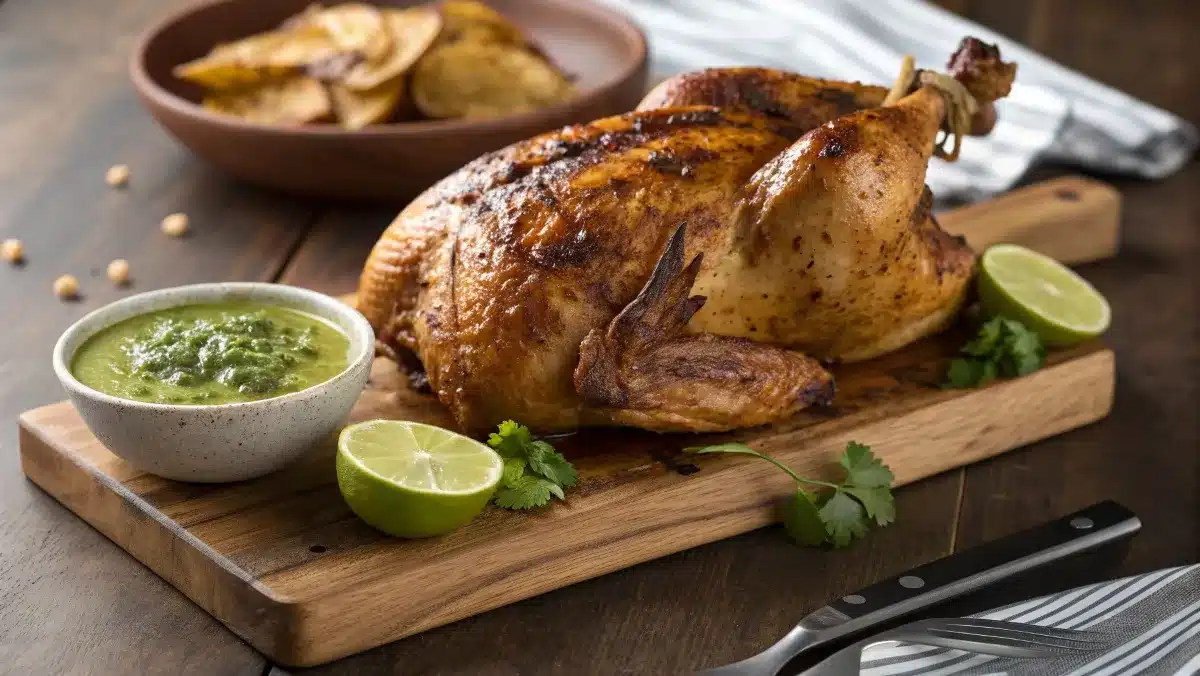Peruvian Chicken Recipe – The Ultimate Guide to Flavorful Pollo a la Brasa
Few dishes capture the heart of a culture quite like the famous Peruvian chicken recipe, also known as Pollo a la Brasa. Bursting with smoky spices, citrusy marinades, and that irresistible crispy skin, this dish has traveled from Lima’s rotisserie ovens to dining tables around the world.
In this guide, we’ll uncover the secrets behind Peru’s most iconic chicken, walk through step-by-step instructions to make it at home, and reveal the magic green sauce that makes every bite unforgettable. Whether you’re a home cook wanting to recreate authentic Peruvian flavors or simply looking for a new way to enjoy chicken, this article will cover it all. And if you love exploring other bold dishes, don’t miss our Steak Seasoning Recipe for inspiration.
Table of Contents
Introduction to Peruvian Chicken
The Popularity of Peruvian Chicken Worldwide
Peruvian chicken has become one of the fastest-growing international food trends. Originally created in the 1950s in Lima, Pollo a la Brasa was once a simple rotisserie dish. Today, it’s served in restaurants across the United States and Europe, often attracting lines out the door. The unique blend of smoky rotisserie cooking and bold Peruvian spices is what sets it apart from ordinary roast chicken.
Brief History of Pollo a la Brasa
The origins of this beloved dish can be traced to Swiss immigrants in Peru, who first experimented with rotisserie cooking techniques. They marinated the chicken with native Peruvian ingredients like aji amarillo and cumin, then slow-roasted it over charcoal. The result was so flavorful that it quickly became a national treasure. Over time, Pollo a la Brasa evolved to represent the fusion of indigenous flavors with European cooking styles.
Why This Dish Stands Out Compared to Other Chicken Recipes
Unlike other roasted chicken dishes, the Peruvian chicken recipe relies heavily on both smoky cooking and a marinade that layers citrus, garlic, cumin, and peppers. This combination produces not only crispy, golden-brown skin but also juicy, tender meat infused with flavor throughout. Add the famous Aji Verde (green sauce), and you’ve got a plate that is as vibrant as it is delicious.
What Makes Peruvian Chicken Unique
Traditional Peruvian Spices and Marinades
The real secret behind the Peruvian chicken recipe lies in its marinade. Unlike plain roasted chicken, this dish uses a mix of bold spices and fresh ingredients to pack flavor into every bite. Garlic, cumin, smoked paprika, black pepper, oregano, and soy sauce form the backbone of the seasoning. What makes it distinctly Peruvian, however, are the chili pastes like aji amarillo (a bright yellow chili pepper with fruity heat) and sometimes aji panca (a mild, smoky red pepper). These chilis give the chicken its signature depth, balancing warmth and smokiness without overwhelming spice.
The Role of Smoky Rotisserie Cooking
Traditionally, Pollo a la Brasa is slow-roasted in a rotisserie oven over charcoal. This method ensures even cooking, while the dripping marinade creates a smoky, irresistible aroma. The chicken’s skin crisps up beautifully, while the inside stays juicy and tender. For those cooking at home, you can achieve similar results by roasting in the oven or grilling. To bring out the same flavors, patience is key—long, slow cooking paired with a well-balanced marinade makes all the difference.
Fusion of Indigenous and International Influences
Peruvian cuisine itself is a fascinating blend of cultures. The chicken’s rotisserie method was introduced by Europeans, while the spices and chili peppers are native to South America. Soy sauce, interestingly, entered Peruvian cooking through Chinese immigrants, creating the distinct flavor combination we enjoy today. This fusion is why Peruvian chicken feels familiar yet exotic—it’s comfort food with a world of history packed into every bite. If you’re looking for more inspiration on flavor-packed marinades, try our Easy Asian Chicken Marinade which also shows how global influences shape delicious chicken dishes.
Ingredients for Authentic Peruvian Chicken Recipe

Essential Spices and Herbs
At the heart of every Peruvian chicken recipe is a rich marinade that defines the dish. The essentials include garlic, cumin, paprika, black pepper, oregano, and a touch of soy sauce. Citrus juice—often lime or lemon—adds brightness and helps tenderize the chicken. But the standout stars are aji amarillo and aji panca. Aji amarillo delivers a fruity heat, while aji panca provides a deep smoky sweetness. Together, they create the unmistakable Peruvian flavor profile.
The Key Role of Vinegar and Citrus in the Marinade
A true Pollo a la Brasa marinade always balances acidity with spice. Vinegar, usually white or apple cider, works with citrus juice to break down the chicken fibers, making the meat incredibly juicy. This acidity also cuts through the richness of the chicken skin, ensuring every bite feels light yet satisfying. Without this balance, the chicken would taste flat and heavy.
Substitutions if Certain Spices Are Unavailable
Not everyone has access to Peruvian chili pastes like aji amarillo. Luckily, there are substitutions that get close in flavor. For heat and fruitiness, a combination of yellow bell pepper and a mild chili can mimic aji amarillo. Smoked paprika can stand in for aji panca if you can’t find it. While purists will argue there’s no replacement for authentic Peruvian peppers, these swaps allow home cooks to enjoy similar flavors without compromise. Looking for a perfect side dish to complement this flavor-packed chicken? Don’t miss our Cilantro Lime Rice in a Rice Cooker, a refreshing match for smoky, spiced chicken.
Step-by-Step Peruvian Chicken Recipe (Pollo a la Brasa)
Preparing the Marinade
The foundation of Pollo a la Brasa is its bold, aromatic marinade. To make it, combine garlic, cumin, smoked paprika, oregano, black pepper, vinegar, soy sauce, lime juice, and aji amarillo paste in a blender or food processor. Blend until smooth and thick. The marinade should taste bold and slightly tangy, with just enough heat to keep it interesting. A good rule of thumb: taste the marinade before applying—it should be strong, because the flavors mellow during cooking.
Marinating Process for Maximum Flavor
For best results, place your chicken in a large resealable bag or covered container. Pour the marinade over it, ensuring every part of the bird is coated. Massage the mixture under the skin whenever possible; this helps the flavor penetrate deeper. Marinate for at least 6 hours, but ideally overnight. The longer the chicken rests in the marinade, the juicier and more flavorful it becomes. If you’re short on time, even 2 hours will make a difference, though the flavor won’t be as intense.
Cooking Methods: Rotisserie, Oven-Roasted, and Grilling Alternatives
- Rotisserie Method (Traditional): Roast the chicken slowly over charcoal, basting it occasionally to lock in smoky flavor. This is the authentic approach, delivering crisp skin and tender meat.
- Oven-Roasted Method: Preheat your oven to 425°F (220°C). Place the chicken on a roasting rack and cook for about 1 hour, or until internal temperature reaches 165°F (74°C). Start with high heat for crisp skin, then reduce the temperature slightly to finish.
- Grilling Alternative: For a backyard version, grill the chicken over indirect heat, turning occasionally. This adds a smoky flavor that’s close to traditional Peruvian cooking.
No matter the method, always let the chicken rest for 10–15 minutes after cooking. This keeps the juices locked in, so every slice is moist and flavorful. For another delicious chicken dinner idea with a creamy twist, check out our Garlic Parmesan Chicken Pasta.
The Famous Green Sauce (Aji Verde)
Ingredients Needed for the Green Sauce
No Peruvian chicken recipe is complete without its bright and creamy companion: Aji Verde. This green sauce is bold, tangy, and just the right amount of spicy. The typical ingredients include:
- Fresh cilantro
- Jalapeños or serrano peppers (sometimes aji amarillo paste for authenticity)
- Garlic
- Lime juice
- Mayonnaise (or Greek yogurt for a lighter version)
- Olive oil
- Cotija or Parmesan cheese for a salty kick
The sauce blends Peruvian ingredients with a touch of global influence, just like the chicken itself.

Flavor Profile of Aji Verde
What makes Aji Verde so special is its balance of flavors. The cilantro and lime add freshness, the chilies bring heat, and the cheese plus mayo give it creamy depth. Unlike many hot sauces, it isn’t just about spice—it’s about layers. The result is a vibrant sauce that enhances the smoky chicken without overpowering it.
How to Make and Store Aji Verde at Home
To prepare, simply blend all ingredients until smooth. Adjust the heat level by adding more or fewer chilies. The sauce should be bright green, creamy, and slightly tangy. Store it in an airtight container in the fridge, where it will stay fresh for up to 5 days. Pro tip: the flavors actually get better after a few hours as they meld together. Pair it with roasted chicken, vegetables, or even sandwiches. If you’re looking for another comforting chicken dish with sauce, don’t miss our Smothered Chicken Recipe for a rich, southern-style classic.
What to Serve with Peruvian Chicken
Classic Peruvian Side Dishes
Peruvian chicken is rarely served alone—it’s meant to be part of a full, vibrant meal. The most traditional sides include French fries (yes, a Peruvian staple!) and a simple salad with creamy dressing. This pairing creates the ideal balance: crispy fries to soak up the sauce and fresh greens to lighten the richness of the chicken.
Rice and Potato-Based Sides
Potatoes are central to Peruvian cuisine, and with over 3,000 varieties in the country, it’s no wonder they often appear next to Pollo a la Brasa. Popular options include roasted potatoes, mashed potatoes with a garlicky kick, or yucca fries for a starchy, golden side. Rice is another common partner—especially cilantro lime rice or plain steamed rice, which soak up the green sauce beautifully. If you’d like to try a comforting rice dish that works with smoky chicken, learn more about our Slow Cooker Chicken Enchiladas—a dish that also loves being paired with flavorful rice.

Modern Twists and Creative Pairings
While the classics are unbeatable, you can also add modern flair. Think roasted vegetables tossed with olive oil and sea salt, quinoa salads for a healthier option, or even plantains for a sweet-savory balance. The goal is to complement the bold chicken without competing with its flavor. With Aji Verde on the side, even the simplest accompaniments shine.
Peruvian Chicken Variations Around the World
Regional Adaptations Within Peru
Even inside Peru, the Peruvian chicken recipe varies from city to city. In Lima, the classic rotisserie style dominates, often served with fries and salad. In the Andes, cooks may add local spices or herbs like huacatay (Peruvian black mint) for a unique aroma. Along the coast, citrus flavors are stronger, influenced by the abundance of fresh limes and seafood-inspired seasoning styles.
International Twists on Peruvian Chicken
When Pollo a la Brasa made its way beyond Peru, it adapted to local tastes while keeping its smoky heart. In the United States, for example, some recipes incorporate chipotle peppers or barbecue-style grilling methods. In Europe, olive oil and Mediterranean herbs sometimes sneak into the marinade. These international spins make the dish approachable for home cooks worldwide without losing its bold personality.
Restaurant vs. Homemade Versions
Eating Peruvian chicken at a restaurant often means you’ll get a perfectly rotisserie-cooked bird, thanks to specialized equipment. However, homemade versions bring flexibility—you can grill, roast, or even air fry your chicken while adjusting the spice level to your preference. Homemade versions also allow for creative experimentation with sides and sauces. If you enjoy exploring regional spins on chicken, check out our Slow Cooker Caprese Chicken for another regional twist that shows how sauces shape a dish’s identity.
Health Benefits and Nutritional Value of Peruvian Chicken
Protein and Nutrient Profile
One of the best things about the Peruvian chicken recipe is that it delivers serious flavor while still being nutrient-rich. Chicken itself is a lean protein source, essential for muscle repair and growth. A serving of rotisserie-style Peruvian chicken (without the skin) offers around 25–30 grams of protein, plus essential vitamins like B6 and niacin. The spices and citrus in the marinade also add antioxidants that support overall wellness.
Healthier Cooking Methods
How you cook your chicken makes a big difference nutritionally. Traditional rotisserie allows fat to drip away, resulting in juicy meat with less grease. Oven roasting is another healthy option, especially if you limit added oils. For a lighter version, use skinless chicken pieces instead of a whole bird. Pairing the dish with grilled veggies or quinoa instead of fries further boosts its nutritional value without losing flavor.
Balancing Flavor with Nutrition
Yes, Peruvian chicken can be indulgent—especially if paired with fries, creamy sauces, or rich sides. But balance is key. By making thoughtful choices like swapping mayonnaise in Aji Verde for Greek yogurt, or replacing fries with roasted sweet potatoes, you get the best of both worlds: authentic taste and healthier eating. For another wholesome yet flavorful option, don’t miss our Low Sodium Chicken Recipes—a dish that proves you don’t need heavy ingredients for bold flavors.
Tips, Tricks, and Common Mistakes to Avoid
Expert Tips for Perfect Flavor
To nail an authentic Peruvian chicken recipe, always start with fresh spices. Pre-ground cumin or paprika that’s been sitting in your pantry for years won’t deliver the same punch. Use freshly squeezed lime juice instead of bottled for that bright acidity. If possible, seek out authentic Peruvian chili pastes (aji amarillo and aji panca)—they’re worth it for that signature taste. Another tip: baste the chicken with its marinade during cooking to keep it moist and layered with flavor.
Common Mistakes Home Cooks Make
One of the biggest mistakes is not marinating long enough. Two hours is fine in a pinch, but overnight is what makes the flavors truly shine. Another misstep is overcrowding the oven or grill. When chickens or pieces are too close together, they steam instead of roast, which results in rubbery skin. Finally, don’t forget to let the chicken rest after cooking—cutting too soon releases all those delicious juices onto the cutting board instead of into your mouth.
Time-Saving Hacks for Busy Cooks
If you’re short on time, try prepping the marinade a day ahead and storing it in the fridge. That way, you just need to coat the chicken when you’re ready. You can also use chicken thighs instead of a whole bird—they marinate faster and cook more quickly. For busy weeknights, pair your chicken with a simple side salad or pre-cooked rice. Looking for inspiration? Try our Easy Leftover Grilled Chicken—a quick and flavorful dish that’s perfect when you need dinner fast.
Conclusion
The Peruvian chicken recipe is more than just a meal—it’s an experience. From its smoky spice rub to the famous green Aji Verde sauce, every bite tells a story of Peru’s culinary heritage. Whether you cook it in a rotisserie, oven, or grill, the magic lies in the marinade, the sides, and the way everything comes together on the plate.
By experimenting with different sides, healthier swaps, or international twists, you can make this dish your own while still keeping its authentic essence. So the next time you’re craving bold flavors, skip the takeout and try this recipe at home. You’ll discover why Pollo a la Brasa has become a global favorite.
Don’t miss our Amazing Chicken Taco Seasoning Recipe if you’re looking for more bold, flavor-packed meals to add to your weeknight rotation.
FAQs
What spices are in Peruvian chicken?
The traditional Peruvian chicken recipe uses a bold spice mix that usually includes cumin, smoked paprika, black pepper, garlic, and oregano. Many recipes also add aji amarillo paste, which gives it a distinct Peruvian flavor with mild heat and a fruity kick.
Why is Peruvian chicken so good?
It’s all about the marinade and cooking style. The blend of spices, citrus, and chili creates deep flavor, while rotisserie or roasting techniques give it crispy skin and juicy meat. Combined with the famous green sauce (Aji Verde), it’s a dish packed with layers of taste.
What does Peruvian chicken taste like?
Peruvian chicken has a smoky, savory, and slightly tangy flavor with hints of spice. The marinade penetrates the meat, so every bite is seasoned. The green sauce adds creaminess and heat, making the overall taste vibrant and addictive.
What is the green sauce that comes with Peruvian chicken?
That sauce is called Aji Verde. It’s a creamy, zesty mix of cilantro, chilies, garlic, lime juice, mayonnaise (or yogurt), and cheese. It balances the richness of the chicken with freshness and a kick of spice.
What do you serve with Peruvian chicken?
Traditionally, Peruvian chicken is served with French fries and a simple salad. Other popular sides include rice, roasted potatoes, yucca fries, or quinoa. The goal is to complement the smoky chicken and dip-friendly sauces.
What is Rocoto sauce?
Rocoto sauce is another Peruvian condiment made with rocoto peppers, which are hotter than jalapeños. It’s spicy, tangy, and slightly fruity, often used in place of Aji Verde for those who love more heat.

